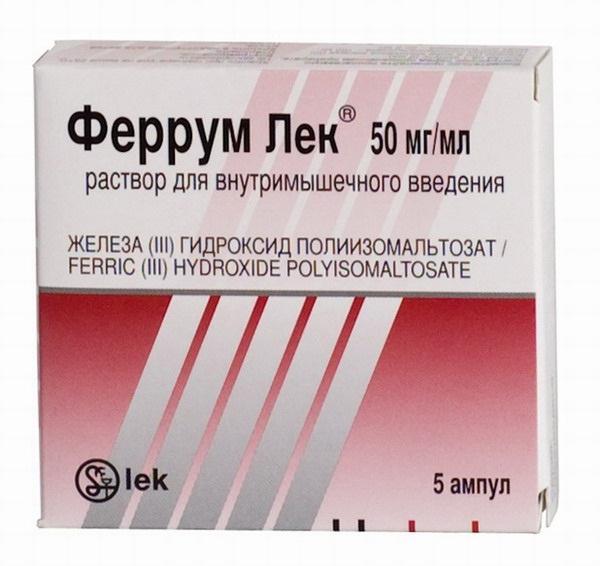Iron is one of the elements without which the human body is not able to fully function. Nevertheless, there is a risk of disruption of its reserves due to the influence of various factors and processes. One of the most common problems is iron deficiency anemia (IDA). It can develop in both children and adults, and even pregnant women are at risk. Given the destructive potential of this disease, it is worth learning more about it.
What should be understood as iron deficiency anemia?
Before studying sideropenic syndrome in case of iron deficiency anemia, it is necessary to touch on the essence of the problem associated with the lack of this microelement. This type of anemia is a pathological condition characterized by a decrease in hemoglobin in the blood due to a noticeable iron deficiency in the body. The deficit itself appears directly due to a violation of its intake and assimilation, or because of the pathological losses of this element.
Iron deficiency anemia (it is also sideropenic) differs from most other anemia in that it does not cause a decrease in red blood cells in the blood. In most cases, it is detected in women of reproductive age, pregnant women and children.
The causes of the disease
Initially, it is worth identifying risk factors in which iron deficiency may appear. Increased iron consumption, followed by the development of anemia, can be caused by repeated pregnancy, heavy periods, lactation and rapid growth during the puberty period. In older people, iron utilization may be impaired. Also in old age, the number of diseases significantly increases, against which anemia develops (intestinal diverticulosis, renal failure, oncopathology, etc.).
To worry about such a problem as iron deficiency is also worthwhile when the assimilation of this element is disrupted at the level of red blood cells (due to insufficient intake of iron with food). As a reason for the development of iron deficiency anemia, it makes sense to consider any diseases that lead to blood loss. These can be tumor and ulcerative processes in the gastrointestinal tract, endometriosis, chronic hemorrhoids, etc. In rare cases, blood loss may occur from the Meckel diverticulum of the small intestine, where a peptic ulcer develops due to the formation of peptin and hydrochloric acid.
Causes of iron deficiency anemia can be associated with glomic tumors in the lungs, pleura and diaphragm, as well as in the mesentery of the intestine and stomach. These tumors, which have a direct connection with the closing arteries, can ulcerate and become a source of bleeding. The fact of hemorrhage is sometimes established in the case of acquired or hereditary pulmonary siderosis, which is complicated by hemorrhage. As a result of this process, iron in the human body is released, followed by its deposition in the lungs in the form of hemosiderin without the possibility of subsequent disposal. Loss of iron in the urine may be due to a combination of diseases such as chronic glomerulonephritis and acquired hemosiderosis of the lungs, which is of an autoimmune nature.

Sometimes the causes of iron deficiency anemia associated with the loss of iron together with blood are directly related to the influence of helminths, which, when introduced into the intestinal wall, cause its damage and, as a result, microblood loss, which can lead to the development of IDA. The risk of this type of anemia is also real for those donors who often donate blood. And as another cause of blood loss worthy of attention, it is possible to determine the hemangioma of the internal organs.
Iron in the human body can be poorly absorbed due to diseases of the small intestine, which occur together with malabsorption syndrome with intestinal dysbiosis and resection of part of the small intestine. Before, quite often one could meet the opinion that atrophic gastritis, which has a decreased secretory function, should be considered as a real cause of iron deficiency anemia. In fact, such a disease can only have an auxiliary effect.
Latent iron deficiency (latent, without clinical signs) can be detected at the biochemical level. Such a deficiency is characterized by the absence or a sharp decrease in the deposits of this microelement in the macrophages of the bone marrow, which can be detected using a special stain. It is worth repeating that at this stage, the loss of iron can be recorded only in the laboratory.
Another symptom that can detect a deficiency is a decrease in serum ferritin.
Symptoms characteristic of iron-containing anemia
In order to make the symptoms more understandable, it makes sense to divide the process of formation of iron deficiency into 3 stages.
Speaking about the first stage, it is worth noting that it is not accompanied by clinical signs. It can only be detected by determining the amount of absorption of radioactive iron in the gastrointestinal tract and the amount of hemosiderin contained in macrophages of the bone marrow.
The second stage can be characterized as latent iron deficiency. It manifests itself through a decrease in exercise tolerance and significant fatigue. All these signs clearly indicate a lack of iron in the tissues due to a decrease in the concentration of iron-containing enzymes. In this state, two processes occur simultaneously: a decrease in the level of ferritin in red blood cells and blood serum, as well as insufficient saturation of transferrin with iron.
The third stage is understood as the clinical manifestation of IDA. The main symptoms of this period include trophic disorders of the skin, nails, hair, sideropenic symptoms (fatigue and general weakness), increased muscle weakness, shortness of breath and signs of cerebral and heart failure (tinnitus, dizziness, pain in the heart, fainting )
Sideropenic symptoms during the third stage include the desire to eat chalk - geophagy, dysuria, urinary incontinence, craving for the smell of gasoline, acetone, etc. With regard to geophagy, in addition to iron deficiency, it may indicate a lack of magnesium and zinc in the body.
Describing the general signs of iron deficiency, you need to pay attention to symptoms such as weakness, loss of appetite, syncope, palpitations, headaches, irritability, low blood pressure, flicker of “flies” in front of the eyes, poor sleep at night and drowsiness during the day, a gradual increase in temperature, a decrease in attention and memory, as well as tearfulness and nervousness.
The effect of sideropenic syndrome
It is important to understand that iron is a component of many enzymes. For this reason, when its deficiency occurs, the activity of enzymes decreases and the normal course of metabolic processes in the body is disturbed. Thus, sideropenic syndrome is the cause of the appearance of many symptoms:
- Skin changes . When iron deficiency occurs, peeling and dryness of the skin can occur, on which cracks appear over time. The occurrence of cracks is possible on the palms of the hands, in the corners of the mouth, on the feet and even in the anus. Hair with this syndrome turns gray early, becomes brittle and actively falls out. About a quarter of patients experience brittle, thinning, and transverse striation of nails. Tissue deficiency of iron actually a consequence of a lack of tissue enzymes.
- Changes in the muscular system . A lack of iron leads to a lack of enzymes and myoglobin in the muscles. This leads to fatigue and weakness. In adolescents, as well as in children, a lack of iron in enzymes provokes a delay in physical development and growth. Due to the fact that the muscle apparatus is weakened, the patient feels an imperative urge to urinate, difficulties with retention of urine during laughter and coughing. Girls with iron deficiency often have to face bedwetting.
Sideropenic syndrome also leads to a change in the mucous membranes of the intestinal tract (cracks in the corners of the mouth, angular stomatitis, an increased tendency to caries and periodontal disease). There is also a change in the perception of odors. With a similar syndrome, patients begin to like the smell of shoe polish, fuel oil, gasoline, gas, naphthalene, acetone, damp earth after rain, varnishes.
Changes affect taste. It is a strong desire to taste such non-food products as tooth powder, raw dough, ice, sand, clay, minced meat, cereals.
With a disease such as sideropenic syndrome, the mucous membranes of the lower and upper membranes of the respiratory tract change. Such changes lead to the development of atrophic pharyngitis and rhinitis. The vast majority of people with iron deficiency develop blue sclera syndrome. As a result of a violation of the hydroskating of lysine, a failure occurs in the process of collagen synthesis.
With iron deficiency, there is a risk of changes in the immune system. We are talking about lowering the level of certain immunoglobulins, B-lysines and lysozyme. There is also a violation of the phagocytic activity of neutrophils and cellular immunity.
With a problem such as sideropenic syndrome, dystrophic changes in internal organs are not ruled out. These include secondary anemic sideropenic myocardial dystrophy. It manifests itself by enhancing the first tone at the apex of the heart and expanding the border of percussion dullness.
With iron deficiency, the state of the digestive tract can also change. We are talking about symptoms such as sideropenic dysphagia, dryness of the mucous membrane of the esophagus and, possibly, its destruction. Patients begin to feel difficulty in swallowing in the evening or in a state of overwork. Perhaps a violation of tissue respiration, leading to a gradual atrophy of the gastric mucosa, in which atrophic gastritis develops. Sideropenic syndrome can also lead to a decrease in gastric secretion, which can result in achilia.
Why does iron deficiency anemia develop in pregnant women?
In women who have a baby, a lack of iron may be due to the appearance of extragenital and gynecological diseases before pregnancy, as well as a high need for iron during the development of the fetus.
Many factors can affect the appearance of a disease such as anemia. Iron deficiency in pregnant women, as a rule, develops for the following reasons:
- the chronic extragenital diseases mentioned above (heart defects, duodenal and gastric ulcers, atrophic gastritis, kidney pathology, helminthic invasions, liver diseases, diseases associated with nosebleeds, and hemorrhoids);
- exposure to a woman’s body of various chemicals and pesticides that can interfere with the absorption of iron;
- congenital deficiency;
- violations of the absorption of iron (chronic pancreatitis, enteritis, resection of the small intestine, intestinal dysbiosis);
- improper nutrition, which is not able to provide the intake of this trace element in the body in the required amount.
Iron deficiency in children
Throughout the entire period of pregnancy, the formation of the basic composition of this trace element in the blood takes place in the body of the child. However, in the third trimester, one can observe the most active intake of iron through the placental vessels. In a full-term child, the normal level of its content in the body should be equal to 400 mg. At the same time, in those children who were born earlier than necessary, this indicator does not rise above 100 mg.

It is important to take into account the fact that breast milk contains enough of this trace element to replenish the reserves of the child's body before the onset of 4 months of age. Therefore, if you stop breastfeeding too soon, the baby may develop iron deficiency. The causes of IDA in children may be associated with the prenatal period. We are talking about various infectious diseases of the mother during pregnancy, with late and early toxicosis, as well as hypoxia syndrome. Depletion of iron reserves can also be affected by factors such as multiple pregnancy with fetal transfusion syndrome, chronic iron deficiency anemia during pregnancy, and uterine-placental bleeding.
In the intrapartum period, the danger is massive bleeding during delivery and premature bandaging of the umbilical cord. As for the postpartum period, at this stage, iron deficiency may result from an accelerated growth rate of the baby, early feeding with whole cow's milk and diseases that are accompanied by impaired intestinal absorption.
Blood test to identify IDA
This diagnostic method is necessary in order to determine a low level of hemoglobin and red blood cells. With its help, hemolytic and iron deficiency anemia can be identified by fixing the morphological characteristics of red blood cells and red blood cells.
In the case of the development of IDA, a biochemical blood test will necessarily show a decrease in the concentration of serum ferritin, an increase in OGSS, a decrease in the concentration of serum iron and a much lower saturation of the transferrin microelement with this trace element.
It is important to know that one day before the test, you can not drink alcohol. Do not eat 8 hours before the diagnosis, only clean water without gas is allowed.
Differential diagnosis
In this case, the medical history can significantly help in the diagnosis. Iron deficiency anemia often develops against the background of other diseases, so this information will be extremely useful. As for the differential approach to diagnosing IDA, it is carried out with those diseases that can cause iron deficiency. At the same time, thalassemia is characterized by clinical and laboratory signs of erythrocyte chemolysis (an increase in the size of the spleen, an increase in the level of indirect bilirubin, hypochromic anemia, reticulocytosis and a high iron content in the depot and blood serum).
Treatment methods
In order to overcome such a problem as a lack of iron in the blood, it is necessary to correctly approach the recovery strategy. An individual approach should be taken for each patient, otherwise it is difficult to achieve the desired level of effectiveness of therapeutic measures.
With a problem such as iron deficiency in the body, treatment primarily involves exposure to a factor that triggers the occurrence of anemia. Correction of this condition with the help of medicines also plays an important role in the healing process.
Attention should be paid to nutrition. In the diet of IDA patients, products that contain heme iron should be included. This is rabbit meat, veal, beef. Do not forget about succinic, citric and ascorbic acids. Replenishment of iron deficiency will help the use of dietary fiber, calcium, oxalates and polyphenols (soy protein, coffee tea, chocolate, milk).
Touching on the topic of drug treatment in more detail, it is worth noting that iron preparations are prescribed for a course of 1.5 to 2 months. After the level of Hb is normalized, maintenance therapy with a half dose of the drug is indicated for 4-6 weeks.
Iron-containing drugs for anemia are taken at a rate of 100-200 mg / day. After the dosage is reduced to 30-60 g (2-4 months). The most popular drugs include the following: Tardiferon, Maltofer, Totem, Ferroplex, Sorbifer, Ferrum Lek. As a rule, medication is taken before meals. The exception is patients who are diagnosed with gastritis and ulcers. The above medicines can not be washed down with products that can bind iron (milk, tea, coffee). Otherwise, their effect will be nullified. It should initially be aware of the harmless side effect that iron-containing drugs are able to produce in case of anemia (referring to the dark color of the teeth). You should not be afraid of such a reaction. As for the unpleasant consequences of drug treatment, the appearance of gastrointestinal disorders (constipation, abdominal pain) and nausea are possible.

The main way of administering drugs with a lack of iron is inside. But in the case of the development of intestinal pathology, in which the absorption process is disturbed, parenteral administration is indicated.
Prevention
In the vast majority of cases, with the help of medical treatment, doctors manage to correct the lack of iron. Nevertheless, the disease can recur and develop again (extremely rare). To avoid such a development of events, prevention of iron deficiency anemia is necessary. This means annual monitoring of the parameters of the clinical blood test, the quick elimination of any causes of blood loss and good nutrition. For those at risk, the doctor may prescribe the necessary medications for preventive purposes.
Obviously, a lack of iron in the blood is a very serious problem. This can be confirmed by any medical history. Iron deficiency anemia, regardless of which patient it is, is a prime example of an extremely destructive disease. Therefore, at the first symptoms of a deficiency of this microelement, you must consult a doctor and undergo a course of treatment in a timely manner.